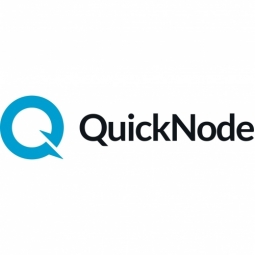Download PDF

QuickNode
Overview
HQ Location
United States
Year Founded
2017
Company Type
Private
Revenue
$10-100m
Employees
51 - 200
Website
Twitter Handle
Company Description
QuickNode is the leading Web3 developer platform, providing infrastructure & tooling for the world's most popular Blockchains (Ethereum, Bitcoin, Polygon, Solana, Fantom, Optimism, xDai, BNB Smart Chain).
IoT Snapshot
QuickNode is a provider of Industrial IoT platform as a service (paas), application infrastructure and middleware, and networks and connectivity technologies, and also active in the buildings, cement, and construction and infrastructure industries.
Technologies
Use Cases
Functional Areas
Industries
Services
Technology Stack
QuickNode’s Technology Stack maps QuickNode’s participation in the platform as a service (paas), application infrastructure and middleware, and networks and connectivity IoT Technology stack.
-
Devices Layer
-
Edge Layer
-
Cloud Layer
-
Application Layer
-
Supporting Technologies
Technological Capability:
None
Minor
Moderate
Strong
Case Studies.
Case Study
QuickNode’s Limitless Calls Per Second Powers Cargo’s NFT Drops on xDai and Matic / Polygon
Cargo, an NFT creation, management, and monetization tool, was facing a significant challenge with its batch minting approach. This approach, which uses the newer ERC-2309 standard, allows creators, developers, and businesses to create an unlimited number of NFTs in one transaction at a similar price-point to creating just one NFT on other platforms. However, batch minting requires a lot of bandwidth. Initially, Cargo connected to the blockchain via another node provider. However, Layer 2 solutions are new chain types and not every provider has the ability to quickly increase capacity. Consequently, Cargo hit rate limits using that service, which slowed requests and at times resulted in not being able to access the Matic / Polygon blockchain. Furthermore, node outages dramatically impacted the platform and its users. If users were in the process of minting NFTs and Cargo suffered a node outage, those NFTs might not show up for users, or might show up blank. This led to increases in support tickets, and decreases in overall customer sentiment.
Case Study
Dune Analytics: Leveraging IoT to Enhance Ethereum Data Analysis
Before the inception of Dune Analytics in 2018, there was a significant challenge in the Ethereum community regarding the analysis of Ethereum activity data. There were limited resources to answer arbitrary questions about Ethereum activity with data or to track how that data evolved over time. A few sites reported specific metrics, but they lacked transparency and flexibility to interact with the metrics and data provided. This lack of comprehensive and interactive data made it difficult to benchmark metrics across different dApps in a meaningful way. Consequently, community discussions and product decisions were often based on inconsistent comparisons or made without considering data at all.
Case Study
Icy.tools Enhances User Experience and Reduces Anxiety with QuickNode
Icy.tools, an NFT Analytics Platform, was facing significant challenges in scaling requests and dealing with rate limits on competing platforms. The company's mission is to make visibility and analysis of transactions in the NFT space more digestible, focusing on indexing blockchain data on ERC721 transfers and OpenSea orders. They collect as much data as possible directly from the blockchain, reducing the risk of relying on third-party services or APIs that can revoke access. However, the volume of requests was causing issues, and they were running into rate limits not just with public endpoints, but also with other node service providers. The co-founders, with over 15 years of experience in building and growing products at early-stage startups, were looking for a solution that could provide more insights and discoverability to the NFT projects for better tracking.





